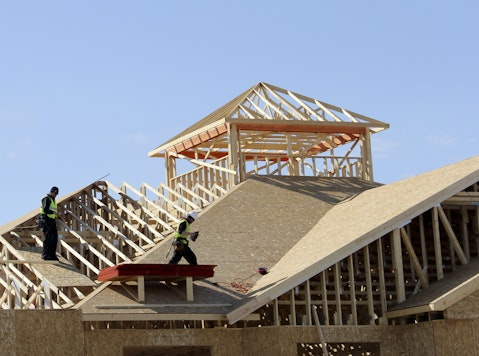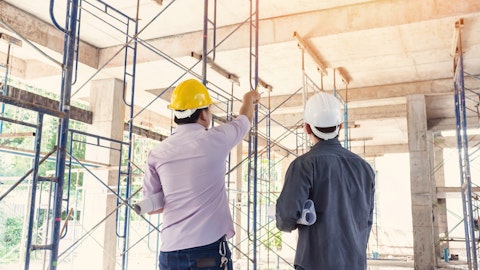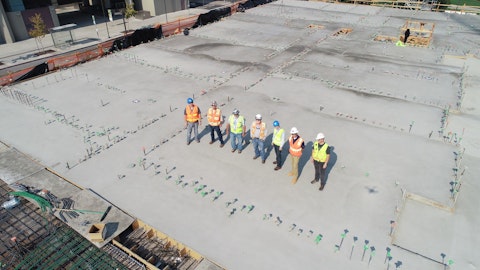Builders FirstSource, Inc. (NYSE:BLDR) Q2 2023 Earnings Call Transcript August 2, 2023
Builders FirstSource, Inc. beats earnings expectations. Reported EPS is $6.26, expectations were $2.69.
Operator: Good day, and welcome to the Builders FirstSource Second Quarter 2023 Earnings Conference Call. Today’s call is scheduled to last about one hour, including remarks by management and the question-and-answer session. [Operator Instructions] I’d now like to turn the call over to Mr. Michael Neese, Senior Vice President, Investor Relations for Builders FirstSource. Please go ahead, sir.
Michael Neese: Thank you, Angela. Good morning and welcome to our second quarter earnings call. With me on the call are Dave Rush, our CEO; and Peter Jackson, our CFO. Today, we will review our results for the second quarter of 2023. The earnings press release and investor presentation are available on our website at investors.bldr.com. We will refer to several slides from the investor presentation during our call. The results discussed today include GAAP and non-GAAP results adjusted for certain items. We provide these non-GAAP results for informational purposes, and they should be considered in isolation from the most directly comparable GAAP measures. You can find the reconciliation of these non-GAAP measures to the corresponding GAAP measures where applicable and a discussion of why we believe they can be useful to investors in our earnings press release, SEC filings and presentation.
Our remarks in the press release, presentation, and on this call contain forward-looking and cautionary statements within the meaning of the Private Securities Litigation Reform Act and projections of future results. Please review the forward-looking statements section in today’s press release and in our SEC filings for various factors that could cause our actual results to differ from forward-looking statements and projections. With that, I’ll turn the call over to Dave.
Dave Rush: Thank you, Mike. Good morning, everyone, and thanks for joining our call. Entering 2023, we prepared for a challenging and dynamic year. During the first half, we had better than anticipated performance, driven by the strength of our value-added product portfolio, continued outperformance in Multi-Family, and a more stable housing environment than originally projected. Multi-Family is an area we identified as providing strong growth potential and in market diversification over the long term. We are truly seeing the differentiated platform we have put together over the past few years generate results. We continue to exceed our near-term targets through contributions from operational initiatives instill over the last few years, and by executing our strategic priorities, which is a testament to the unwavering commitment and dedication of our amazing team members.
We are focused on delivering exceptional customer service and always strive to be the easiest company in the industry to do business with. We’re driving mixed improvement through value added share growth, while continuing to expand through tuck-in acquisitions. Our acquisitions in recent years have allowed us to enhance our value-added offerings and also extend our reach to a more diverse customer base in attractive markets. Moreover, these acquisitions have proven to be immediately accretive to our earnings. We continue to consistently generate robust free cash flow and prudently deploy capital, making two tuck-in acquisitions and repurchasing over $700 million of shares in the second quarter alone. Despite the headwinds posed by elevated mortgage rates and affordability challenges, our resilient results in the first half of 2023 give us confidence that we have the right strategies in place with a customer-centric approach and an incredible team that is executing at the highest level to successfully navigate this dynamic economic environment.
Many single-family builders are showing stabilizing demand partially due to widespread shortages of existing homes for sale, driving healthy new construction. Public builders have been reporting a stream of stronger-than-expected results and taking proactive steps, such as interest rate buy-downs to help get prospective buyers off the sidelines. With home prices normalizing in many places, our focus on value-added solutions, digital innovations and customer service is helping builders improve their construction efficiencies. We are helping our customers lower cycle time, which is highlighted by our continued improvement on in full deliveries from 93% last year to 96%, during the second quarter. On time and in full deliveries ensure our customers have the right material at the right time.
Looking at our second quarter highlights on slide 4. Our gross margin percentage increased 40 basis points to 35.2% due to stronger mix in value-added products overall, largely driven by our Multi-Family segment and the related positive impact from commodity cost timing. We maintained a healthy double-digit adjusted EBITDA margin, showcasing our ability to execute effectively from an operations perspective in a challenging environment. This execution is a reflection of our talented field leadership team, which averages 30-plus years of industry experience. Turning to slide 5. We drove strong productivity across the business by delivering $50 million in savings during the quarter. Our BFS One Team Operating System continues to generate robust efficiencies, focused on manufacturing and delivery improvement.
Our recent acquisitions in Multi-Family contributed an increase of 4% on the top-line and 9% to EBITDA compared to the prior year quarter. Multi-Family was an exceptionally strong tailwind this quarter, and we expect this streak to continue for the remainder of 2023. While we expect Multi-Family to normalize around the first or second quarter of next year, we remain optimistic that, Single-Family starts will be on stronger footing in the same period, compared to the first half of 2023. As it relates to our cost structure, controlling SG&A and other expenses remains a vital focus for us. This includes the ongoing optimization of our footprint and balancing the need for variable cost reductions against future capacity needs. We are focused on our discretionary spending, and our team has done a great job on managing costs in the short-term, while executing our strategy over the long-term.
Turning to M&A on slide 6. We continue to target attractive opportunities with a disciplined approach. Thus far in 2023, we have completed four deals and are still committed to our goal of investing an average of $500 million in M&A per year for the next several years. During the second quarter, we added millwork capabilities through the acquisitions of JB Millworks and Builders Millwork Supply. And earlier this week, we acquired Church’s Lumber, which expands our presence and scale in the Detroit market. We’re excited to welcome our talented new team members to the BFS family. Our M&A and organic investments have substantially increased our value-added product mix and diversified our end markets since Q4 2021, as shown on slide 6. We have seen the fruit of this growth in recent quarters, and we have driven our gross margins higher even in a down housing starts environment.
Moving to slide 7. I would like to provide an update on capital allocation. In the second quarter, we deployed over $850 million of capital towards organic growth investments, tuck-in M&A and share repurchases. We have cumulatively deployed approximately $5.3 billion since the end of 2021 and remain on track to achieve our 2025 goal of $7 billion to $10 billion communicated at our Investor Day in 2021. Now let’s turn to slide 8 for an update on our digital strategy. We firmly believe our long-term commitment to new digital innovations and technologies will deliver greater efficiency across homebuilding and enhance our product and service offerings. We continue to play a pioneering role in the digital transformation of the homebuilding industry and have made a significant investment in growing our digital platform.
We have made it a priority to ensure digital adoption is integrated across our operations as we seek to create a platform that will lead to building better, more affordable homes. myBLDR.com serves as the entry point to our collaborative project management platform. It is designed to create efficiency for both BFS and our customers by offering improved transparency and engagement in the homebuilding process. It combines Paradigm’s next-generation estimating technology with our 3D Home Configuration model. Together, these tools allow our customers more control over their design, cost estimating and building process ultimately saving both our customers and their clients, time and money. We are still in early innings and have more to come as we continue to roll out these digital solutions to our end users but we remain confident in our ability to gain an incremental $1 billion in product sales by 2026.
We believe our sustained commitment to investing in digital innovations and technologies will extend BFS’ lead as the partner of choice in the market, and we look forward to providing more detail on our long-term strategy at our Investor Day in December. Before I turn the call over to Peter, I want to say how grateful I am to our team members for continuing to execute in a challenging environment and providing excellent service to our customers on a daily basis. At BFS, we keep our high-performing, people-first culture at the heart of all we do. That’s why we like to recognize team members in our organization that embody the true spirit of our, Be More, Do More, Build More together philosophy. Perla Jover is an Inventory Control Supervisor in Houston, Texas, who has made a huge impression on her managers and colleagues.
In May, she was honored as one of our first team MVPs for exemplifying our core values. Perla’s attitude — positive attitude for willingness to jump in and help in her pursuit of excellence really makes a difference on the team. The supervisors appreciate how she embraces learning new skills and mentoring others, especially young women new to our industry. Employees like Pearl make me proud to lead this great organization. Without the full effort of our team, we would not have had the outperformance that we achieved during the first half of this year. I’ll now turn the call over to Peter to discuss our second quarter financial results in greater detail.
Peter Jackson: Thank you, Dave, and good morning, everyone. Our performance during the quarter further highlighted the resilience of our business in the face of macro pressures. I’m particularly proud of our gross margin results driven by our increased mix of value-added products and services. We are well positioned in the marketplace with differentiated solutions and a healthy balance sheet. We continue to generate robust free cash flow and prudently deploy capital. I’m confident that the combination of our industry-leading scale, ongoing investments in value-added and digital products, and strong financial position will lead to a double-digit adjusted EBITDA margin this year, and sustained growth in the years to come. I will cover three topics with you this morning.
First, I’ll recap our second quarter results. Second, I’ll provide an update on capital deployment. And finally, I’ll discuss our full year 2023 guidance. Let’s begin by reviewing our second quarter performance on slide 10. We delivered $4.5 billion in net sales. Core organic sales decreased by 22%, which was better than expected, despite a 31% decline in Single-Family due to slower demand over the prior year. Multi-Family continues to be a bright spot, growing by nearly 30%. As Dave mentioned, the strength in Multi-Family was driven by our recent acquisitions as well as favorable margins, largely attributable to the longer lead time for this end market. R&R and other grew by nearly 5%, mainly due to increased sales focus and capacity versus the prior year.
The cumulative effect of our acquisitions over the past year contributed approximately 4 percentage points of growth to net sales. Importantly, value-added products represented 53% of our net sales this quarter versus 45% in the fourth quarter of 2021, reflecting our improving position as a supplier of choice for these higher-margin products. During the second quarter, gross profit was $1.6 billion, a decrease of 33.9% compared to the prior year period. Gross margin increased 40 basis points to 35.2%, driven primarily by a stronger mix in value-added products overall and with particular strength in Multi-Family value-add. SG&A decreased $28 million to $1.02 billion, mainly due to lower variable compensation, partially offset by additional expenses from operations acquired in the last year.
Acquisitions increased SG&A by $52 million in the quarter. As a percentage of net sales, total SG&A increased by 740 basis points to 22.5%, primarily attributable to decreased leverage on net sales. We remain focused on operating efficiently, containing costs and effectively integrating operations and acquisitions. Adjusted EBITDA was approximately $769 million, a decline of 49%, primarily driven by lower net sales, including a decline in core organic products attributable to a slower housing market and commodity deflation. Adjusted EBITDA margin remained a robust 17%, up 70 basis points sequentially as we continue to execute and drive improved productivity across the business. Adjusted net income was $498 million, down from an adjusted net income of $1.07 billion in the prior year quarter.
The 54% decrease in adjusted net income was primarily driven by a decrease in sales volumes and commodity deflation. Adjusted earnings per diluted share were $3.89 compared to $6.26 in the prior year period. The decrease in adjusted EPS was partially offset by our repurchase of nearly 7 million shares, which added roughly $0.20 per share during quarter. Our second quarter results exceeded the guidance we provided in May, supported by our core business mix and gross margin strength amid outperformance in value-added products. We continue to gain confidence in the strength and durability of our margin performance, and we believe our long-term normalized gross margin percentage is now at 29%-plus versus our previous expectation of 28%-plus. Now, let’s turn to our cash flow, balance sheet and liquidity on slide 12.
Our second quarter operating cash flow was approximately $391 million, down $556 million compared to the prior year period, mainly attributable to commodity deflation and a reduction in Single-Family starts. Capital expenditures were $121 million. All in, we delivered healthy free cash flow of approximately $270 million. For the trailing 12 months ended June 30, our free cash flow yield was 17.7%, while operating cash flow return on invested capital was 41.4%. Our net debt to adjusted EBITDA ratio was approximately 1.1 times, while base business leverage was 1.6 times. Excluding our ABL, we have no long-term debt maturities until 2030. At quarter end, our total liquidity was approximately $900 million, consisting of $800 million in net borrowing availability under the revolving credit facility and $100 million of cash on hand.
Moving to capital deployment. During the second quarter, we repurchased approximately 7 million shares for $723 million at an average stock price of $103.68 per share. In total, we have repurchased approximately 41% of our outstanding shares since August of 2021. We have approximately $s600 million remaining on our most recent $1 million share repurchase authorization from April 2023. We remain disciplined stewards of capital, and we’ll continue to look for organic and inorganic growth opportunities while maintaining our fortress balance sheet. Let’s turn to our outlook on slide 14. Our July sales trends are encouraging and fuel our confidence in the resilience of our industry. Several of our national customers have begun to provide full year guidance, providing us with better visibility and greater confidence in the strength of the market.
As a result, we are establishing our full year base business and total company guidance as we enter the back half of 2023. Our base business approach showcases the underlying strength and profitability of our company by normalizing for commodity volatility. As a reminder, our base business definition assumes normalized margins and static commodity prices at $400 per 1,000 board feet. This is helpful to clearly assess the core aspects of the business where we have focused our attention to drive sustainable outperformance in our industry. Our base business guide on net sales is $16.6 billion. Our base business EBITDA guide is $2.2 billion at a margin of roughly 13.3%. At this time, we are also providing total company guidance for full year 2023, including total net sales, gross margins, adjusted EBITDA and adjusted EBITDA margin.
For full year 2023, we expect total company net sales to be $16.8 billion to $17.8 billion. We expect adjusted EBITDA to be $2.6 billion to $2.9 billion. Adjusted EBITDA margin is forecasted to be 15% to 17%. And we are guiding gross margins to a range of 33% to 35%. Our recent above normal margins reflected greater mix in value-added products along with disciplined pricing required to offset our increases in operating costs from inflation. As we move through the second half of the year, we expect both our gross margins and Multi-Family business to continue to normalize. We expect full year 2023 free cash flow of $1.6 billion to $2 billion. Our free cash flow forecast assumes average commodity prices in the range of $400 to $450. Our 2023 outlook is based on several assumptions.
Please refer to our earnings release and slide 15 of the investor presentation for a full list of these assumptions. As I wrap up, I want to reiterate that we are exceptionally well positioned to drive our strategic goals. Our guidance illustrates our belief that we will deliver a double-digit adjusted EBITDA margin this year and sustain that momentum in the years to come. As we continue to reap the benefits of our transformed business, we are positioned to achieve an upwardly revised long-term normalized gross margin of 29% or higher. I’m confident that our best-in-class operating platform will continue to generate substantial free cash flow, providing further financial flexibility on top of our already healthy balance sheet. Importantly, we will continue to diligently deploy capital and maximize long-term shareholder value.
With that, let me turn the call back over to Dave for some final thoughts.
Dave Rush: Thanks, Peter. Let me close by saying that we feel better about the current building environment today than we did at the beginning of the year. We’re executing our strategy and continuing to invest to drive future growth. Our results in the first half reflect our hard work over the past few years to build a differentiated platform that has BFS set up to win in any environment. I am proud of our operational excellence, which is driving increased safety, productivity and profitability despite market headwinds. We are in a great position today and as end markets further stabilize, we are positioned for an even stronger future. We’ll continue to be at the forefront of technology with our digital strategy, which I’m confident will be a game changer for the industry.
We are exceptionally well positioned to drive shareholder value this year and in years to come. I’m excited to share more details at our upcoming Investor Day on December 5th in Atlanta and look forward to seeing you there. Thank you again for joining us today. Operator, let’s please open the call now for questions.
See also 11 Best Magic Formula Stocks to Buy Now and 25 States with the Worst Drivers.
Q&A Session
Follow Builders Firstsource Inc. (NASDAQ:BLDR)
Follow Builders Firstsource Inc. (NASDAQ:BLDR)
Operator: [Operator Instructions] Our first question today comes from Matthew Bouley with Barclays.
Matthew Bouley: Good morning, everyone. Thanks for taking the questions. And congrats on the results. I’ll start with the question on the long-term gross margin guide, which you’ve now raised twice consecutively. So, my question is, what’s changed in the past 90 days that’s kind of given you that incremental confidence? And then, of course, to take another step forward, given your gross margin of 33% to 35% this year, what are the signs you’d be looking for to kind of give you step in — or confidence in yet another step higher from that 29%. So, I’ll pause there. That’s the first question.
Peter Jackson: Well, first of all, thanks, Matt. We appreciate it. We’re excited about the business and certainly pleased with the way gross margins have been continuing to evolve. We’ve talked about it for — well, a couple of years now, actually. The strength of the core business, particularly post merger and what we’ve been able to do to grow value-add as a mix of our business has been very impactful. And what we’ve continued to look for, particularly this year, is the normalization, right, with the supply chain getting back to normal, the reset and the level of starts, we were really concerned about what that would mean in terms of the overall market’s ability to sustain margins. I don’t think we were alone in that.
What we’ve looked for this year is the performance being at a stable level. And while we’re not quite there yet, we’ve certainly seen stability be established in a lot of parts of the market, a lot of regions, a lot of product categories where we’ve seen things sort of get to normal and level out. When we talk about gross margins, it can be a little bit misleading. Again, this quarter, we saw a substantial tailwind due to Multi-Family, what I would describe as sort of transitory tailwinds. At least a couple of hundred basis points this quarter was really just due to the way the commodity timing, the cost of commodities played out versus some of our contracts. So, we’re pleased with it. Obviously, we’ll take it. But we don’t want to signal to anybody that that’s permanent.
And we still have certain areas of the market where things continue to normalize, and we’re not quite sure where things will end up, but we know the pressure is down. We’ve certainly seen that. We’re up 40 bps overall on gross margins. But certainly, that indicates if you take out Multi-Family, some pretty decent step-down in the core, that’s what we thought was going to happen, and that’s pretty much how it’s played out, and we’ll continue to look for that. But even with all of that said, it’s better than we expected. We certainly have gained a lot of confidence in the strength of our business, the strength of value-add, which continues to be really, really desirable for our builder customers, and we’re continuing to invest in it and feel good about what that means for normal margins going forward.
We’ll continue to monitor it. I mean, we’ve left the plus at the end because we think — obviously, we’re performing better than that now, and we’re just going to wait and see where things normalize over time.
Dave Rush: Hey Matt, thanks again. This is Dave. I would just add, since the merger with BMC, we’ve invested over $100 million in upgrading and automating our manufacturing capabilities, and we’re starting to see the fruits of that. And we’re getting a better feel of how that’s going to contribute to margins over the longer period as well.





